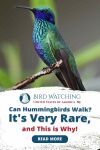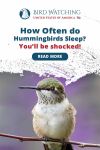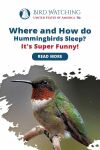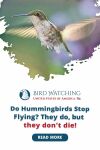
What’s This Post About?
You can often recognize a hummingbird in your backyard through its chirp, size, and colorful features. They may fly to the feeders and visit it often to refuel themselves. A question that you may have in mind is, do hummingbirds walk?
If you are interested in knowing more about the walking capabilities of a hummingbird, I would suggest you invest in a good pair of binoculars and read up on relevant guides. This will enable you to study the moving pattern of each hummingbird individually.
It is a known fact that hummingbirds cannot walk. They use their feet to build nests, fight, perch, or scratch themselves. They hover and fly to feed themselves, but they cannot walk due to their weak, short, and disproportionate legs. They can shuffle sideways in slow motion to cover short distances.
What Is the Feet Structure of a Hummingbird?
Hummingbirds have small feet with four toes: three toes in the front and one toe at the back.

Most hummingbirds have four toes in total. The one toe at the back is scientifically called the ‘hallux’. The hallux functions the same way as the thumb of human works. It helps the bird to grip onto something and maintain its balance. The hallux helps the birds perch on a tree branch or a wire.
The ratio of the leg to foot length is disproportionate. Their legs are knee-less which also adds to the difficulty. These factors do not allow these dainty creatures to walk around.
Interesting Fact
Hummingbirds belong to a bird order known as ‘Apodiformes’, which means footless in Latin even though hummingbirds have feet!
What Do Hummingbirds Use Their Feet and Legs For?
Hummingbirds with the help of their legs can perch, fight, scratch, and build a nest.
It is a very rare sight to see a hummingbird walk, very rare! The question is if they cannot walk then what else do they use their feet for? Here’s the answer.
1. Scratching

For hummingbirds, scratching their bodies is an essential part of their hygiene routine. Scratching helps them get rid of mites that have infected their bodies over time.
With the help of their feet, they can easily scratch the mites off making sure they stay infection-free throughout.
The reason why the removal of mites is crucial is that the mites may cause them to go bald as their feathers start falling off. Once the hummingbird’s heads are mite-free, their feathers will grow back within 3 weeks.
Add To Your Knowledge
Since the hummingbird’s legs are short and knee-less, they have an interesting style of bringing their legs backward from over their wings. This shortens the distance and helps them reach out to their head and neck area.
2. Perching

Perching is a frequent activity for hummingbirds. They usually perch at the tip of a branch or a wire at a certain height.
For them, perching does not always mean resting or taking a break. Hummingbird perch to look out for predators or other dangers that can emerge.
They pick out a spot with the least distraction such as a branch with fewer leaves that might block their view. Since they cannot walk, they shuffle side by side on these branches or wires to keep an eye on their territory.
If you want to look at a hummingbird shuffling sideways, then you can create or purchase a small hummingbird swing with nectar on both ends for the hummingbirds to perch on and move.
Aspects HummZinger HighView 12 Oz Hanging Hummingbird Feeder
The feeder includes a high view perch that invites hummingbirds to rest comfortably as they drink from any of four feeding ports while also offering an unobstructed view of the birds.
3. Building A Nest

Female hummingbirds not only use their feet to defend themselves but also to create a small comfy home for themselves that will fit their bean-sized eggs.
They need to make sure that along with being beautiful and attractive, their nests are strong, sturdy, and durable. This will create a safe environment for them to raise the young.
To build this masterpiece, hummingbirds use their beak to grasp the materials required to prepare their nests. These materials include grass, cotton, tiny twigs, plant stuff, and animal fur.
These raw materials will then be combined and layered with spider webs which act as glue to merge the nest materials.
The layering process requires the hummingbird to use its feet. The feet will act as a hammer to shape and form the nest, giving the nest a sturdy base so that the layers do not break off easily.
Fun Fact
Only the female hummingbirds are involved in creating the nest. They only lay two eggs in each nest. The male hummingbird will then find another mate as soon as the eggs hatch!
4. Fighting
Hummingbirds are possessive and aggressive when it comes to defending their territory. They use the beak and feet as a weapon to fight.
Most hummingbirds have sharp and pointed beaks which makes it easy for them to tackle other birds. However, it is not known but hummingbirds also use their feet to guard themselves and bring themselves closer to the food source.
When a fight takes place between two hummingbirds, they use both their feet to grab onto the neck of the other bird to push them off their food.
This fight cannot be witnessed through a naked eye. A slow-motion video may make it easier for you to observe this conflict step-by-step though or a pair of good binoculars.
Leupold BX-2 Alpine Binocular
You will love this product! It offers features like: smooth precision central focusing dial, twist up adjustable eyecups, tri-pod ready adapter allow for all day glassing comfort
Interesting Fact
Hummingbirds have a sharp memory and can remember all the routes that they have visited. They also visit their previous territory, when they return, in search of food.
Do Hummingbirds Land on The Ground?
Since hummingbirds cannot walk, they usually do not prefer settling on the ground. Occasionally if you see a hummingbird on the ground, do not trouble them.
Hummingbirds, as read above, are not capable of walking on the ground. They may hop or shuffle sideways because of their tiny legs that do not support the gravitational pull.
If a hummingbird is seen sitting still on the ground, you can adopt certain tactics to make sure they are safe.
The following table consists of a few steps you can follow when you see a hummingbird on the ground:
| Step | Instructions |
|---|---|
| Inspect for danger | Look around to see if the hummingbird has been injured by any dangerous substance around that area. |
| Watch | Observe the bird for 10 to 15 minutes to see if it moves, proving it to be alive. |
| Hold the bird | If the bird is still for quite some time, try to cup your hands and pick it up. |
| Find a warm location | Try to place the hummingbird in a warm area such as between crumpled tissues or a small box with a warm cloth inside. |
| Feed the bird | You can make nectar at home and feed the bird via an eyedropper or a syringe. Nectar can be made with 4 parts of water mixed with 1 part of sugar. |
| Set it free | Once you feel that the injured bird is now fit to fly, set it free. |
Warning
Monitor the hummingbird’s breathing. If it is breathing by opening its bill then it is too warm and requires aid to cool down. If the body of a hummingbird is fluffed, then it is too cold and requires warmth!
Keep Reading!
Hummingbirds are beautiful creatures, their inability to walk does not make them weak instead their legs are their strength when it comes to scratching, fighting, building a nest, or perching. Hummingbirds portray their strength in their wings and flying capabilities.
This post helped explain that hummingbirds cannot walk and use their feet for multiple other purposes. The structure of a hummingbird’s legs is also explained, supporting the statement of why hummingbirds cannot walk.
If you are interested to watch and observe these beautiful little creatures and the alternatives they adapt to move around, then you must indulge in bird watching.
If you do not have any experience in bird watching, then you can read up on our post to start your journey of bird watching.
Backyard Bird Watching Essential Gear for Beginners - Fantastic & Amazing Guide
Are you interested in knowing what could make your bird-watching experience enthralling? Read on to find out about the essential gear you need to own.

By David A. Swanson
Bird Watching USA
My name is David and I'm the the founder of Bird Watching USA! I started Bird Watching with My father-in-law many years ago, and I've become an addict to watching these beautiful creatures. I've learnt so much over about bird watching over the years that I want to share with the world everything I know about them!

David A. Swanson
Bird Watching USA
My name is David and I'm the the founder of Bird Watching USA! I started Bird Watching with My father-in-law many years ago, and I've become an addict to watching these beautiful creatures. I've learnt so much over about bird watching over the years that I want to share with the world everything I know about them!











